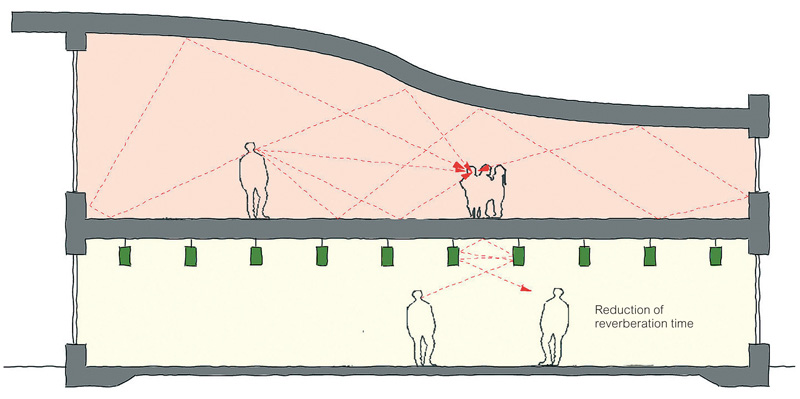Reverberation in buildings
Contents |
[edit] Introduction
Sound is caused by vibrations which transmit through a medium such as air and reach the ear or some other form of detecting device. Sound intensity is measured in Decibels (dB). This is a logarithmic scale in which an increase of 10 dB gives an apparent doubling of loudness.
Approved document E, Resistance to the passage of sound defines 'Reverberation' as the persistence of sound in a space after a sound source has been stopped. Reverberation time is the time, in seconds, taken for the sound to decay by 60dB after a sound source has been stopped.
The reverberation time of a room is linked to the the surfaces that enclose it and the volume of the room by the Sabine equation:
RT = Volume x 0.161 / Total Acoustic Absorption
Image: To control reverberation time, acoustic absorption is used.
Room acoustics / reverberation affects the way a space sounds. A high reverberation time can make a room sound loud and noisy. Speech intelligibility is also a function of reverberation, a high reverberation time causes speech to sound muffled and muddy. Rooms designed for speech therefore typically have a low reverberation time: ≤1 second. A high reverberation time can enhance a music hall by adding richness, depth and warmth to music. A higher level of reverberation within a concert hall is therefore critical.
The illustration below provides indicative reverberation times for a range of building types and room volumes.
[edit] Acoustic properties of materials
To control reverberation time, acoustic absorption is used. Absorbent materials conventionally take two forms; fibrous materials or open-celled foam. Fibrous materials absorb sound as sound waves force the fibres to bend and this bending of the fibres generates heat. The conversion of acoustic energy into heat energy results in the sound effectively being absorbed. In the case of open-celled foam, the air movement resulting from sound waves pushes air particles through the narrow passages which in turn generate a viscous loss along with heat.
Architecturally, fibrous materials and open celled foams are not always considered attractive or robust. It is common therefore to cover these materials with an acoustically transparent finish such as a tissue, cloth or slatted wood, or with perforated materials such as wood, metal, plasterboard and so on.
The thickness of a given material along with properties such as its fibrousity governs its acoustic performance. Finishes within a space are defined in terms of their absorption coefficient. This is a number between 0.0 (100% reflective) for example stone, tiles or concrete and 1.0 (100% absorbent), for example high performance acoustic ceiling tiles, slabs of mineral wool, etc. Products such as carpets typically have an absorption coefficient between 0.1 and 0.3 depending on their thickness. Perforated plasterboard generally provides around 0.6 to 0.7.
It is also common to classify absorbent materials in categories, A to E, where A is highly absorbent and E is almost fully reflective.
This article was created by --MACH Acoustics 11:04, 28 November 2013 (UTC)
[edit] Related articles on Designing Buildings Wiki
- Airborne sound.
- Approved Document E.
- Building acoustics.
- Building Bulletin 93: acoustic design of schools.
- Decibel.
- Flanking sound.
- Impact sound.
- Noise nuisance.
- Robust details certification scheme.
- Room acoustics.
- Sound insulation.
- Sound absorption.
- Sound frequency.
- Sound insulation testing.
- Sound power.
- Sound v noise.
- Noise nuisance.
[edit] External references
- MACH Acoustics: Room acoustics and reverberation.
Featured articles and news
Infrastructure that connect the physical and digital domains.
Harnessing robotics and AI in challenging environments
The key to nuclear decommissioning and fusion engineering.
BSRIA announces Lisa Ashworth as new CEO
Tasked with furthering BSRIA’s impressive growth ambitions.
Public buildings get half a million energy efficiency boost
£557 million to switch to cleaner heating and save on energy.
CIOB launches pre-election manifesto
Outlining potential future policies for the next government.
Grenfell Tower Inquiry announcement
Phase 2 hearings come to a close and the final report due in September.
Progress from Parts L, F and O: A whitepaper, one year on.
A replicated study to understand the opinion of practitioners.
ECA announces new president 2024
Electrical engineer and business leader Stuart Smith.
A distinct type of countryside that should be celebrated.
Should Part O be extended to existing buildings?
EAC brands heatwave adaptation a missed opportunity.
Definition of Statutory in workplace and facilities management
Established by IWFM, BESA, CIBSE and BSRIA.
Tackling the transition from traditional heating systems
59% lack the necessary information and confidence to switch.
The general election and the construction industry
As PM, Rishi Sunak announces July 4 date for an election.
Eco apprenticeships continue help grow green workforce
A year after being recognised at the King's coronation.
Permitted development rights for agricultural buildings
The changes coming into effect as of May 21, 2024.
























